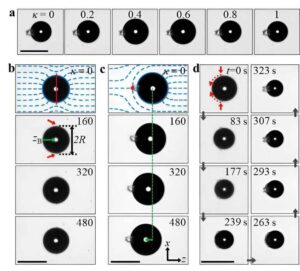A research team affiliated with UNIST has unveiled for the first time a new principle of motion in the microworld, where objects can move in a directed manner simply by changing their sizes periodically within a substance known as liquid crystal.
Led by Professor Jonwoo Jeong and his research team in the Department of Physics at UNIST, this discovery is poised to have far-reaching implications across various research fields, including the potential future development of miniature robots. The paper is published in the journal Nature Communications.

In their research, the team observed that air bubbles within the liquid crystal could move in one direction by altering their sizes periodically, contrary to the symmetrical growth or contraction typically seen in air bubbles in other mediums. By introducing air bubbles comparable in size to a human hair into the liquid crystal and manipulating the pressure, the researchers were able to demonstrate this extraordinary phenomenon.
The key to this phenomenon lies in the creation of phase defects within the liquid crystal structure next to the air bubbles. These defects disrupt the symmetrical nature of the bubbles, enabling them to experience a unidirectional force despite their symmetrical shape. As the air bubbles fluctuate in size, pushing and pulling the surrounding liquid crystal, they are propelled in a consistent direction, defying conventional laws of physics.

Sung-Jo Kim, the first author of the study, remarked, “This groundbreaking observation showcases the ability of symmetrical objects to exhibit directed motion through symmetrical movements, a phenomenon previously unseen.” He further highlighted the potential applicability of this principle to a wide range of complex fluids beyond liquid crystals.
Professor Jeong commented, “This intriguing result underscores the significance of symmetry breaking in both time and space in driving motion at the microscopic level. Moreover, it holds promise for advancing research in the development of microscopic robots.”
Reference: Sung-Jo Kim et al, Symmetrically pulsating bubbles swim in an anisotropic fluid by nematodynamics, Nature Communications (2024). DOI: 10.1038/s41467-024-45597-1
